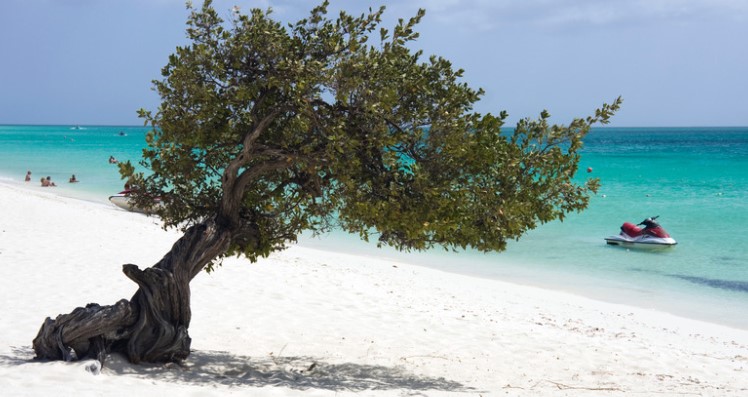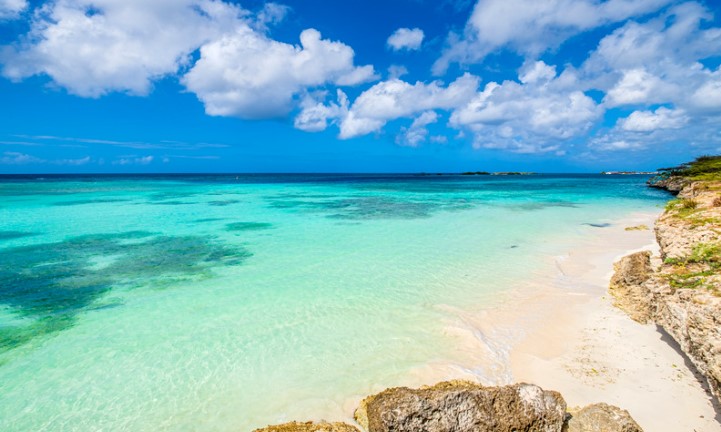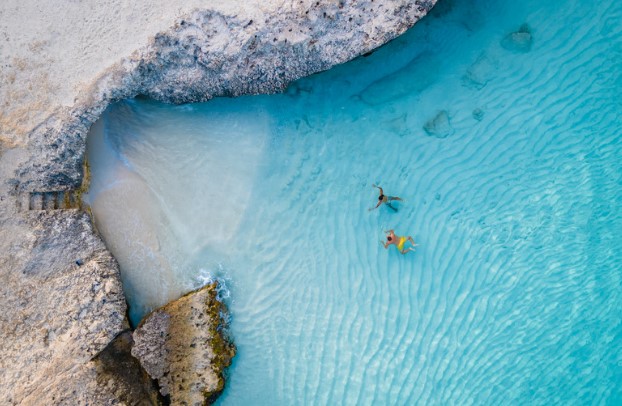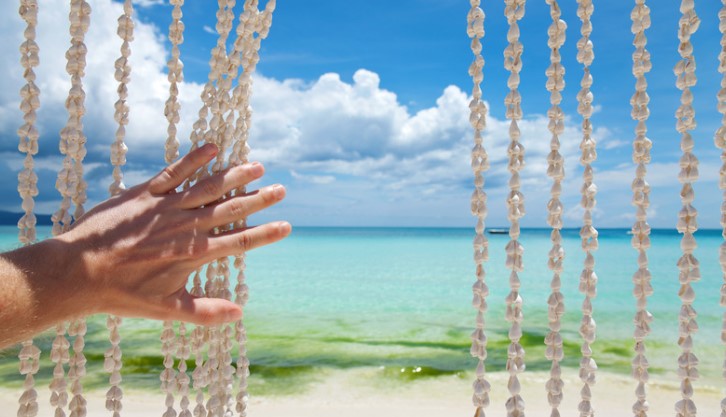Aruba vs. Cancun: Unraveling the Charm of Two Tropical Titans

When choosing a tropical paradise for a sun-soaked getaway, two names often stand out in the minds of travellers: Aruba and Cancun. Nestled within the warm embrace of the Caribbean Sea, these two stunning beach destinations promise blue waters, vibrant nightlife, and an array of outdoor activities that leave visitors spellbound.
But why are Aruba and Cancun so often juxtaposed in the debates of eager vacationers? Is it the allure of Aruba’s Eagle Beach or the historical intrigue of Cancun’s Mayan ruins? It’s the clash between the laid-back vibes of Palm Beach and the bustling energy of Cancun’s Hotel Zone. With their beautiful beaches and unique offerings, both locations cater to a wide range of preferences, making them hot topics for discussion among globe-trotters.
Whether you’re a beach bum searching for the softest white sandy beaches or a history enthusiast looking to explore ancient ruins, these Caribbean destinations always emerge as strong contenders. As we dive deeper into the distinct characteristics of these paradises, we’ll uncover the gems that make each of them an impeccable choice for your next vacation destination.
Geographical Gems: Where Aruba and Cancun Claim Their Spots
Aruba: The Star of the A-B-C Islands
Aruba, a pint-sized Caribbean gem, is part of the famed A-B-C islands, including Bonaire and Curaçao. Situated just off the northern coast of Venezuela, this beautiful island is characterized by its arid climate and sunny weather. With its position outside the hurricane belt, Aruba boasts of Hurricane-Free Days, making it an attractive vacation destination throughout the year. However, when the weather conditions are most fantastic, the peak season stretches from mid-December to mid-April.
Cancun: Mexico’s Tropical Crown
Perched on the northeastern tip of Mexico’s Yucatán Peninsula, Cancun offers breathtaking views of the Caribbean Sea’s turquoise waters. Unlike Aruba’s arid island landscape, Cancun enjoys a tropical climate with distinct wet and dry seasons. While the sunny weather is prevalent most of the year, travellers often opt for visits during the peak season, from December to April, to avoid the rainy season, which runs from May to October. Yet, even during the rainy season, the showers are typically short-lived, and the sun is never too shy for long.
Essentially, both Aruba and Cancun offer travellers a taste of tropical paradise. Whether you’re drawn to Aruba’s consistent sunny skies or the dynamic weather patterns of Cancun, understanding their geographical nuances ensures you pick the ideal destination aligned with your travel desires.
A Dive into Times Past: The Cultural and Historical Pulse of Aruba and Cancun
Aruba: A Mosaic of Cultures and Histories
Long before the lavish resorts and international cuisines made their mark, Aruba was home to the indigenous Arawak people, specifically the Caquetío Indians. They left behind a rich tapestry of petroglyphs in places like Arikok National Park, silently narrating tales from centuries ago. The island’s historical narrative took a turn in the early 16th century with the arrival of Spanish explorers, who left an indelible impact on its culture and architecture. Today, Aruba celebrates its multicultural lineage through vibrant festivals like the ‘Bon Bini Festival’ – a weekly event showcasing music, dance, and Aruban cuisine.
Cancun: From Mayan Majesty to Modern Marvel
Nestled in what was once the heartland of the Mayan Empire, archaeological sites and ancient ruins surround Cancun, the most famous of which is ‘El Rey’. These historical sites stand as a testament to a powerful civilization known for its advanced knowledge of astronomy and architecture. The Spanish influence, beginning in the 16th century, blended with the indigenous culture, giving rise to a unique cultural amalgamation. Cancun’s vibrant festivals, like the ‘Day of the Dead’ and the ‘Cancun Jazz Festival’, beautifully encapsulate this blend of ancient traditions and modern influences.
For both Aruba and Cancun, their rich histories are not just confined to the pages of textbooks. They come alive in their local festivals, traditions, and everyday life. Whether it’s the echoes of the Caquetío Indians in Aruba’s national parks or the haunting beauty of Mayan ruins in Cancun, visitors are transported to an era long gone but never forgotten.
Sands, Shores, and Nature’s Splendors: Aruba vs. Cancun
Aruba’s Beachfront Bliss
The beaches of Aruba are the stuff of postcards. “From the world-renowned Eagle Beach with its iconic foot trees and pristine white sandy beaches to the more secluded Baby Beach, perfect for families and those seeking tranquil waters, Aruba offers a diverse array of coastal delights. The shimmer of Aruba’s beaches is further amplified by Palm Beach and Arashi Beach, both of which showcase crystal-clear waters ideal for snorkelling and observing the colourful marine life.
Not to be missed is Aruba’s Natural Bridge. This coral limestone formation was one of the Caribbean’s largest and most photographed natural bridges before it collapsed in 2005. However, the smaller Baby Natural Bridge still stands nearby and offers a breathtaking view.
Cancun’s Coastal Charms
Cancun, a Caribbean city, lures beach enthusiasts with its impeccable beaches like Playa Delfines, where turquoise waters meet soft, sandy shores, and Playa Norte, celebrated for its calm waters and beach access. However, what truly sets Cancun apart is its proximity to the cenotes, natural limestone caves filled with fresh water, offering visitors a unique swimming and diving experience amidst stalactites and stalagmites.
The MUSA (Underwater Museum of Art) near Isla Mujeres is a testament to Cancun’s commitment to marine conservation. Here, divers and snorkelers can explore over 500 life-sized sculptures submerged in the turquoise waters, creating an artificial reef that promotes marine life growth.
Dive into Nature’s Aquarium
Both destinations promise underwater adventurers a treat. While Aruba’s coral reefs, brimming with vibrant marine life, beckon divers, Cancun offers the ethereal experience of swimming alongside whale sharks during their migration between June and September.
In the showdown between these two tropical paradises, it’s clear that both Aruba and Cancun offer their unique takes on beach beauty and natural allure. Whether it’s the cenotes’ allure or the natural bridge’s historic charm, visitors are spoilt for choice in these stunning beach destinations.
Thrills, Spills, and Nights to Remember: Aruba and Cancun’s Entertainment Extravaganza
Aruba’s Palette of Pleasures
For thrill-seekers, Aruba offers a range of water sports, from windsurfing off Hadicurari Beach to scuba diving near Mangel Halto. The Arikok National Park provides families with a taste of Aruba’s natural landscapes and native species.
Gusto Night Club Aruba and the Electric Festival pump up the beats when night falls. At the same time, local spots like The Paddock and Ricardo’s Restaurant & Bar offer a mix of live music ranging from jazz to traditional Aruban sounds. The island’s nightlife has a laid-back and intimate vibe, blending the international with the local.
Cancun’s Adrenaline Rush
Cancun’s adventures are both above and below the water. Popular cenotes like Dos Ojos and Gran Cenote invite divers to explore underwater caves and tunnels. Activities like ziplining through the jungle or exploring ancient ruins beckoning on land.
Cancun’s nightlife is more boisterous, with its famous Coco Bongo Club and Senor Frogs offering extravagant shows and dance floors. The city pulsates with modern beats and traditional rhythms, presenting a more commercialized party atmosphere than Aruba.
Rest and Recreation: Aruba and Cancun’s Accommodation Options
Aruba: A Blend of Luxury and Local
Aruba presents varied accommodation choices. Brickell Bay Beach Club & Spa cater efficiently to those on a budget. Luxury seekers might drift towards the Ritz-Carlton or Renaissance Aruba Resort & Casino. Overwater bungalows, a newer addition growing in popularity, are being introduced by resorts to offer guests a slice of isolated paradise. However, they’re more prevalent in the Maldives and Bora Bora areas.
Cancun’s Cornucopia
Cancun ranges from budget-friendly options like the Selina Cancun to ultra-luxe resorts like the Le Blanc Spa Resort. Over-the-water bungalows also feel their presence here, with resorts like the Palafitos at El Dorado Maroma offering this immersive experience.
When comparing accommodations, Cancun generally offers more expansive resorts and all-inclusive packages, potentially providing better value for money. While possessing luxury resorts, Aruba often delivers a more boutique and intimate hotel experience.
While both Aruba and Cancun promise luxury and relaxation, the choice boils down to one’s preference – a commercialized hub of entertainment or a cosy blend of local charm and luxury.
A Feast for the Senses: Aruba and Cancun’s Culinary Landscape
Aruba’s Gastronomic Gems
Aruba, a melting pot of cultures, offers a delectable fusion of flavours. Staples like Keshi Yena (a spiced meat stew encased in a shell of melted cheese) and the Aruban Pastechi (a deep-fried pastry filled with cheese, meat, or seafood) are must-tries. For a refreshing drink, nothing beats the local Balashi beer or a glass of Coecoei, a bright red liquor unique to Aruba.
Regarding dining, Zeerovers is the go-to for fresh seafood. At the same time, The Old Cunucu House introduces visitors to traditional Aruban dishes in a historical setting. The Dutch influence is evident in many dishes. Still, there’s also a sprinkle of Latin American and Indonesian flavours, thanks to the island’s diverse settlers.
Cancun’s Culinary Canvas
Cancun tantalizes taste buds with its rich Mexican flavours, from the hearty Cochinita Pibil (slow-roasted pork) to fresh Ceviche. For those with a sweet tooth, Churros and Flan are delightful choices. Regarding drinks, Mezcal and Tequila are the stars, often enjoyed in cocktails like the Margarita.
Lorenzillo’s is renowned for its lobster dishes, while La Habichuela offers a romantic ambience with traditional Mayan and Mexican cuisine. The food scene here is predominantly influenced by ancient Mayan cooking techniques combined with a Spanish flair from the colonial era.
Journeying to and through Paradise: Travel and Safety Tips
Aruba’s Travel Tapestry
Reaching Aruba is a breeze with its well-connected Queen Beatrix International Airport. Once on the island, travelling is relatively straightforward. Buses ply regularly, and taxis operate without meters, so settling on a fare before starting the trip is advisable. Renting a car or scooter might be ideal for a more flexible itinerary.
Safety-wise, Aruba boasts a reputation as one of the safer Caribbean islands. Nevertheless, basic precautions like avoiding deserted areas at night and securing valuables are recommended.
Navigating Cancun
Cancun International Airport welcomes flights from all over the globe. Within the city, buses like the R1 and R2 are affordable and convenient for tourists, while taxis are plentiful. Those venturing to more secluded areas might consider car rentals.
As a popular tourist hotspot, Cancun generally maintains high safety standards in the Hotel Zone. However, travellers should remain vigilant, especially in less touristy areas, avoiding late-night outings and always being wary of pickpockets.
In Aruba and Cancun, it’s essential to respect local customs and stay informed about travel advisories or local news to ensure a smooth and memorable vacation.
Pricing Paradise: Navigating Costs in Aruba and Cancun
Aruba’s Wallet Considerations
In Aruba, the average daily cost for a tourist might hover around $200-$300, with luxury resorts such as the Ritz-Carlton demanding higher rates. Dining out can range from $10 at local eateries to $50 or more at upscale restaurants. Activities, especially niche ones like private sailing tours, can command prices upwards of $100.
Budgeting Tips in Aruba:
- Opt for local dining spots instead of tourist-centric restaurants.
- Consider visiting during the off-peak season for discounted accommodation rates.
- Utilize public transport or rent bicycles for local commutes.
Cancun’s Financial Footprint
With its wide range of accommodations, Cancun can cater to both budget travellers and luxury seekers. A modest budget hotel costs as low as $50 per night, while lavish resorts charge $300 and upwards. Meals range from $5 for street food to $40 at premier dining establishments. Popular activities like exploring the cenotes or visiting Mayan ruins can vary from $30 to $150.
Budgeting Tips in Cancun:
- Embrace the street food scene for delicious yet pocket-friendly meals.
- Book all-inclusive packages that bundle accommodation, food, and sometimes activities.
- Travel during the shoulder season to snag deals and avoid massive crowds.
Value for Money: On comparing the two, Cancun might offer slightly better value for money, especially given its array of all-inclusive resorts and diverse activity ranges. However, Aruba’s unique charm and cultural mosaic provide a different value altogether.
Treading Lightly: Sustainable Tourism in Aruba and Cancun
Aruba’s Eco Initiatives
Aruba has been steering towards sustainable tourism, aiming to become fully sustainable by 2020. The island has made strides in reducing its water footprint, encouraging coral reef protection, and promoting ecotourism. The Arikok National Park is a testament to Aruba’s dedication to preserving its natural wonders.
Cancun’s Green Steps
Recognizing the strain of heavy tourism, Cancun has initiated measures to protect its ecosystems. Programs to protect sea turtles, sustainable hotel certifications, and encouragement of ecotourism activities like responsible cenote exploration highlight their efforts. The Mesoamerican Barrier Reef System, just off Cancun’s coast, has several protection initiatives to ensure its preservation.
Eco-travel Tips:
- Choose accommodations that have sustainability certifications.
- Participate in eco-tours, ensuring they adhere to responsible guidelines.
- Respect local habitats, avoid littering, and minimize your carbon footprint.
In both destinations, the emphasis on sustainable tourism is evident, and as travellers, understanding, respecting, and supporting these initiatives ensures these paradises remain pristine for generations to come.
Aruba vs Cancun: Choosing Your Slice of Paradise
Aruba and Cancun, with their azure waters and golden sands, are embodiments of the dream tropical vacation. But, they each offer distinct experiences tailored for various traveller personas.
Aruba’s Allure
With its unique blend of cultures, this Caribbean gem offers a laid-back atmosphere. Its diverse culinary scene, historical sites like ancient ruins, and intimate nightlife are particularly enticing. The arid climate ensures sunny days, making it a haven for sun-worshippers. Furthermore, its consistent efforts toward sustainable tourism are commendable, ensuring every visit leaves a minimal footprint.
Cancun’s Charm
A lively hotspot, Cancun pulsates with energy. With its rich Mayan heritage, bustling nightlife, and a plethora of adventure activities (from diving in cenotes to exploring archaeological sites), it’s no wonder that this Mexican jewel has become a global favourite. The all-inclusive resort culture here ensures that every traveller can find something they like, irrespective of their budget.
Tailoring Your Trip:
- For Families: Aruba, with its family-friendly activities, serene beaches like Baby Beach, and safe environment, is an excellent pick. Cancun, with attractions like the Interactive Aquarium and the Croco Cun Zoo, ensures the little ones are entertained.
- For Couples: Those seeking a romantic escapade might find Aruba’s quiet beaches and intimate dining spots more to their liking. However, Cancun’s lavish resorts and breathtaking views at places like Playa Delfines can be equally enchanting.
- With its vibrant nightlife and plethora of group activities, Solo Travellers: Cancun can be a paradise for solo wanderers looking to meet people. On the other hand, Aruba provides a tranquil backdrop for self-reflection and relaxation.
- Adventure Seekers: Cancun edges out slightly with its underwater museums, cenote diving, and proximity to ancient Mayan ruins. However, Aruba’s desert landscapes and national parks offer a different kind of thrill.
Ultimately, whether it’s the serene shores of Aruba or the energetic vibes of Cancun, the choice hinges on the kind of experience you seek. Both promise unforgettable memories, vivid sunsets, and the allure of the tropics. The world is your oyster, and these two are undoubtedly its pearls! Safe travels and sun-soaked adventures await.
Aruba vs Cancun: Unraveling the Charm of Two Tropical Titans
When choosing a tropical paradise for a sun-soaked getaway, two names often stand out in the minds of travellers: Aruba and Cancun. Nestled within the warm embrace of the Caribbean Sea, these two stunning beach destinations promise blue waters, vibrant nightlife, and an array of outdoor activities that leave visitors spellbound.
But why are Aruba and Cancun so often juxtaposed in the debates of eager vacationers? Is it the allure of Aruba’s Eagle Beach or the historical intrigue of Cancun’s Mayan ruins? It’s the clash between the laid-back vibes of Palm Beach and the bustling energy of Cancun’s Hotel Zone. With their beautiful beaches and unique offerings, both locations cater to a wide range of preferences, making them hot topics for discussion among globe-trotters.
Whether you’re a beach bum searching for the softest white sandy beaches or a history enthusiast looking to explore ancient ruins, these Caribbean destinations always emerge as strong contenders. As we dive deeper into the distinct characteristics of these paradises, we’ll uncover the gems that make each of them an impeccable choice for your next vacation destination.
Geographical Gems: Where Aruba and Cancun Claim Their Spots
Aruba: The Star of the A-B-C Islands
Aruba, a pint-sized Caribbean gem, is part of the famed A-B-C islands, including Bonaire and Curaçao. Situated just off the northern coast of Venezuela, this beautiful island is characterized by its arid climate and sunny weather. With its position outside the hurricane belt, Aruba boasts of Hurricane-Free Days, making it an attractive vacation destination throughout the year. However, when the weather conditions are most fantastic, the peak season stretches from mid-December to mid-April.
Cancun: Mexico’s Tropical Crown
Perched on the northeastern tip of Mexico’s Yucatán Peninsula, Cancun offers breathtaking views of the Caribbean Sea’s turquoise waters. Unlike Aruba’s arid island landscape, Cancun enjoys a tropical climate with distinct wet and dry seasons. While the sunny weather is prevalent most of the year, travellers often opt for visits during the peak season, from December to April, to avoid the rainy season, which runs from May to October. Yet, even during the rainy season, the showers are typically short-lived, and the sun is never too shy for long.
Essentially, both Aruba and Cancun offer travellers a taste of tropical paradise. Whether you’re drawn to Aruba’s consistent sunny skies or the dynamic weather patterns of Cancun, understanding their geographical nuances ensures you pick the ideal destination aligned with your travel desires.
A Dive into Times Past: The Cultural and Historical Pulse of Aruba and Cancun
Aruba: A Mosaic of Cultures and Histories
Long before the lavish resorts and international cuisines made their mark, Aruba was home to the indigenous Arawak people, specifically the Caquetío Indians. They left behind a rich tapestry of petroglyphs in places like Arikok National Park, silently narrating tales from centuries ago. The island’s historical narrative took a turn in the early 16th century with the arrival of Spanish explorers, who left an indelible impact on its culture and architecture. Today, Aruba celebrates its multicultural lineage through vibrant festivals like the ‘Bon Bini Festival’ – a weekly event showcasing music, dance, and Aruban cuisine.
Cancun: From Mayan Majesty to Modern Marvel
Nestled in what was once the heartland of the Mayan Empire, archaeological sites and ancient ruins surround Cancun, the most famous of which is ‘El Rey’. These historical sites stand as a testament to a powerful civilization known for its advanced knowledge of astronomy and architecture. The Spanish influence, beginning in the 16th century, blended with the indigenous culture, giving rise to a unique cultural amalgamation. Cancun’s vibrant festivals, like the ‘Day of the Dead’ and the ‘Cancun Jazz Festival’, beautifully encapsulate this blend of ancient traditions and modern influences.
For both Aruba and Cancun, their rich histories are not just confined to the pages of textbooks. They come alive in their local festivals, traditions, and everyday life. Whether it’s the echoes of the Caquetío Indians in Aruba’s national parks or the haunting beauty of Mayan ruins in Cancun, visitors are transported to an era long gone but never forgotten.
Sands, Shores, and Nature’s Splendors: Aruba vs. Cancun
Aruba’s Beachfront Bliss
The beaches of Aruba are the stuff of postcards. “From the world-renowned Eagle Beach with its iconic foot trees and pristine white sandy beaches to the more secluded Baby Beach, perfect for families and those seeking tranquil waters, Aruba offers a diverse array of coastal delights. The shimmer of Aruba’s beaches is further amplified by Palm Beach and Arashi Beach, both of which showcase crystal-clear waters ideal for snorkelling and observing the colourful marine life.
Not to be missed is Aruba’s Natural Bridge. This coral limestone formation was one of the Caribbean’s largest and most photographed natural bridges before it collapsed in 2005. However, the smaller Baby Natural Bridge still stands nearby and offers a breathtaking view.
Cancun’s Coastal Charms
Cancun, a Caribbean city, lures beach enthusiasts with its impeccable beaches like Playa Delfines, where turquoise waters meet soft, sandy shores, and Playa Norte, celebrated for its calm waters and beach access. However, what truly sets Cancun apart is its proximity to the cenotes, natural limestone caves filled with fresh water, offering visitors a unique swimming and diving experience amidst stalactites and stalagmites.
The MUSA (Underwater Museum of Art) near Isla Mujeres is a testament to Cancun’s commitment to marine conservation. Here, divers and snorkelers can explore over 500 life-sized sculptures submerged in the turquoise waters, creating an artificial reef that promotes marine life growth.
Dive into Nature’s Aquarium
Both destinations promise underwater adventurers a treat. While Aruba’s coral reefs, brimming with vibrant marine life, beckon divers, Cancun offers the ethereal experience of swimming alongside whale sharks during their migration between June and September.
In the showdown between these two tropical paradises, it’s clear that both Aruba and Cancun offer their unique takes on beach beauty and natural allure. Whether it’s the cenotes’ allure or the natural bridge’s historic charm, visitors are spoilt for choice in these stunning beach destinations.
Thrills, Spills, and Nights to Remember: Aruba and Cancun’s Entertainment Extravaganza
Aruba’s Palette of Pleasures
For thrill-seekers, Aruba offers a range of water sports, from windsurfing off Hadicurari Beach to scuba diving near Mangel Halto. The Arikok National Park provides families with a taste of Aruba’s natural landscapes and native species.
Gusto Night Club Aruba and the Electric Festival pump up the beats when night falls. At the same time, local spots like The Paddock and Ricardo’s Restaurant & Bar offer a mix of live music ranging from jazz to traditional Aruban sounds. The island’s nightlife has a laid-back and intimate vibe, blending the international with the local.
Cancun’s Adrenaline Rush
Cancun’s adventures are both above and below the water. Popular cenotes like Dos Ojos and Gran Cenote invite divers to explore underwater caves and tunnels. Activities like ziplining through the jungle or exploring ancient ruins beckoning on land.
Cancun’s nightlife is more boisterous, with its famous Coco Bongo Club and Senor Frogs offering extravagant shows and dance floors. The city pulsates with modern beats and traditional rhythms, presenting a more commercialized party atmosphere than Aruba.
Rest and Recreation: Aruba and Cancun’s Accommodation Options
Aruba: A Blend of Luxury and Local
Aruba presents varied accommodation choices. Brickell Bay Beach Club & Spa cater efficiently to those on a budget. Luxury seekers might drift towards the Ritz-Carlton or Renaissance Aruba Resort & Casino. Overwater bungalows, a newer addition growing in popularity, are being introduced by resorts to offer guests a slice of isolated paradise. However, they’re more prevalent in the Maldives and Bora Bora areas.
Cancun’s Cornucopia
Cancun ranges from budget-friendly options like the Selina Cancun to ultra-luxe resorts like the Le Blanc Spa Resort. Over-the-water bungalows also feel their presence here, with resorts like the Palafitos at El Dorado Maroma offering this immersive experience.
When comparing accommodations, Cancun generally offers more expansive resorts and all-inclusive packages, potentially providing better value for money. While possessing luxury resorts, Aruba often delivers a more boutique and intimate hotel experience.
While both Aruba and Cancun promise luxury and relaxation, the choice boils down to one’s preference – a commercialized hub of entertainment or a cosy blend of local charm and luxury.
A Feast for the Senses: Aruba and Cancun’s Culinary Landscape
Aruba’s Gastronomic Gems
Aruba, a melting pot of cultures, offers a delectable fusion of flavours. Staples like Keshi Yena (a spiced meat stew encased in a shell of melted cheese) and the Aruban Pastechi (a deep-fried pastry filled with cheese, meat, or seafood) are must-tries. For a refreshing drink, nothing beats the local Balashi beer or a glass of Coecoei, a bright red liquor unique to Aruba.
Regarding dining, Zeerovers is the go-to for fresh seafood. At the same time, The Old Cunucu House introduces visitors to traditional Aruban dishes in a historical setting. The Dutch influence is evident in many dishes. Still, there’s also a sprinkle of Latin American and Indonesian flavours, thanks to the island’s diverse settlers.
Cancun’s Culinary Canvas
Cancun tantalizes taste buds with its rich Mexican flavours, from the hearty Cochinita Pibil (slow-roasted pork) to fresh Ceviche. For those with a sweet tooth, Churros and Flan are delightful choices. Regarding drinks, Mezcal and Tequila are the stars, often enjoyed in cocktails like the Margarita.
Lorenzillo’s is renowned for its lobster dishes, while La Habichuela offers a romantic ambience with traditional Mayan and Mexican cuisine. The food scene here is predominantly influenced by ancient Mayan cooking techniques combined with a Spanish flair from the colonial era.
Journeying to and through Paradise: Travel and Safety Tips
Aruba’s Travel Tapestry
Reaching Aruba is a breeze with its well-connected Queen Beatrix International Airport. Once on the island, travelling is relatively straightforward. Buses ply regularly, and taxis operate without meters, so settling on a fare before starting the trip is advisable. Renting a car or scooter might be ideal for a more flexible itinerary.
Safety-wise, Aruba boasts a reputation as one of the safer Caribbean islands. Nevertheless, basic precautions like avoiding deserted areas at night and securing valuables are recommended.
Navigating Cancun
Cancun International Airport welcomes flights from all over the globe. Within the city, buses like the R1 and R2 are affordable and convenient for tourists, while taxis are plentiful. Those venturing to more secluded areas might consider car rentals.
As a popular tourist hotspot, Cancun generally maintains high safety standards in the Hotel Zone. However, travellers should remain vigilant, especially in less touristy areas, avoiding late-night outings and always being wary of pickpockets.
In Aruba and Cancun, it’s essential to respect local customs and stay informed about travel advisories or local news to ensure a smooth and memorable vacation.
Pricing Paradise: Navigating Costs in Aruba and Cancun
Aruba’s Wallet Considerations
In Aruba, the average daily cost for a tourist might hover around $200-$300, with luxury resorts such as the Ritz-Carlton demanding higher rates. Dining out can range from $10 at local eateries to $50 or more at upscale restaurants. Activities, especially niche ones like private sailing tours, can command prices upwards of $100.
Budgeting Tips in Aruba:
- Opt for local dining spots instead of tourist-centric restaurants.
- Consider visiting during the off-peak season for discounted accommodation rates.
- Utilize public transport or rent bicycles for local commutes.
Cancun’s Financial Footprint
With its wide range of accommodations, Cancun can cater to both budget travellers and luxury seekers. A modest budget hotel costs as low as $50 per night, while lavish resorts charge $300 and upwards. Meals range from $5 for street food to $40 at premier dining establishments. Popular activities like exploring the cenotes or visiting Mayan ruins can vary from $30 to $150.
Budgeting Tips in Cancun:
- Embrace the street food scene for delicious yet pocket-friendly meals.
- Book all-inclusive packages that bundle accommodation, food, and sometimes activities.
- Travel during the shoulder season to snag deals and avoid massive crowds.
Value for Money: On comparing the two, Cancun might offer slightly better value for money, especially given its array of all-inclusive resorts and diverse activity ranges. However, Aruba’s unique charm and cultural mosaic provide a different value altogether.
Treading Lightly: Sustainable Tourism in Aruba and Cancun
Aruba’s Eco Initiatives
Aruba has been steering towards sustainable tourism, aiming to become fully sustainable by 2020. The island has made strides in reducing its water footprint, encouraging coral reef protection, and promoting ecotourism. The Arikok National Park is a testament to Aruba’s dedication to preserving its natural wonders.
Cancun’s Green Steps
Recognizing the strain of heavy tourism, Cancun has initiated measures to protect its ecosystems. Programs to protect sea turtles, sustainable hotel certifications, and encouragement of ecotourism activities like responsible cenote exploration highlight their efforts. The Mesoamerican Barrier Reef System, just off Cancun’s coast, has several protection initiatives to ensure its preservation.
Eco-travel Tips:
- Choose accommodations that have sustainability certifications.
- Participate in eco-tours, ensuring they adhere to responsible guidelines.
- Respect local habitats, avoid littering, and minimize your carbon footprint.
In both destinations, the emphasis on sustainable tourism is evident, and as travellers, understanding, respecting, and supporting these initiatives ensures these paradises remain pristine for generations to come.
Aruba vs Cancun: Choosing Your Slice of Paradise
Aruba and Cancun, with their azure waters and golden sands, are embodiments of the dream tropical vacation. But, they each offer distinct experiences tailored for various traveller personas.
Aruba’s Allure
With its unique blend of cultures, this Caribbean gem offers a laid-back atmosphere. Its diverse culinary scene, historical sites like ancient ruins, and intimate nightlife are particularly enticing. The arid climate ensures sunny days, making it a haven for sun-worshippers. Furthermore, its consistent efforts toward sustainable tourism are commendable, ensuring every visit leaves a minimal footprint.
Cancun’s Charm
A lively hotspot, Cancun pulsates with energy. With its rich Mayan heritage, bustling nightlife, and a plethora of adventure activities (from diving in cenotes to exploring archaeological sites), it’s no wonder that this Mexican jewel has become a global favourite. The all-inclusive resort culture here ensures that every traveller can find something they like, irrespective of their budget.
Tailoring Your Trip:
- For Families: Aruba, with its family-friendly activities, serene beaches like Baby Beach, and safe environment, is an excellent pick. Cancun, with attractions like the Interactive Aquarium and the Croco Cun Zoo, ensures the little ones are entertained.
- For Couples: Those seeking a romantic escapade might find Aruba’s quiet beaches and intimate dining spots more to their liking. However, Cancun’s lavish resorts and breathtaking views at places like Playa Delfines can be equally enchanting.
- With its vibrant nightlife and plethora of group activities, Solo Travellers: Cancun can be a paradise for solo wanderers looking to meet people. On the other hand, Aruba provides a tranquil backdrop for self-reflection and relaxation.
- Adventure Seekers: Cancun edges out slightly with its underwater museums, cenote diving, and proximity to ancient Mayan ruins. However, Aruba’s desert landscapes and national parks offer a different kind of thrill.
Ultimately, whether it’s the serene shores of Aruba or the energetic vibes of Cancun, the choice hinges on the kind of experience you seek. Both promise unforgettable memories, vivid sunsets, and the allure of the tropics. The world is your oyster, and these two are undoubtedly its pearls! Safe travels and sun-soaked adventures await.










